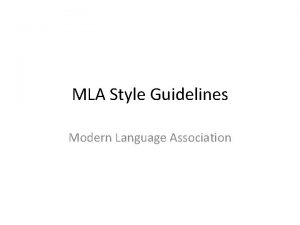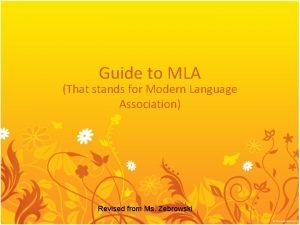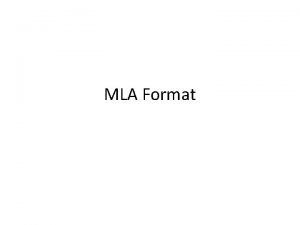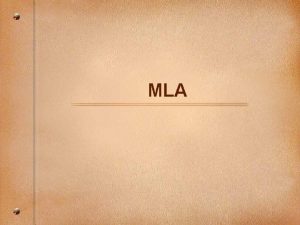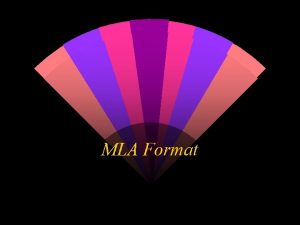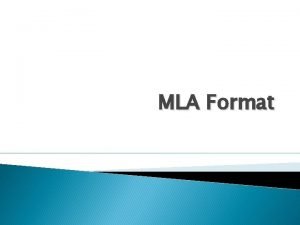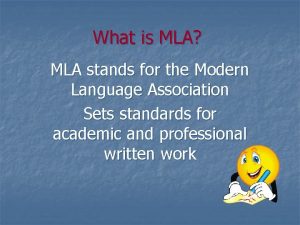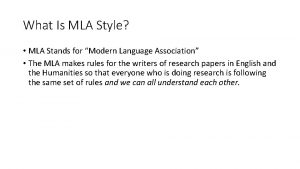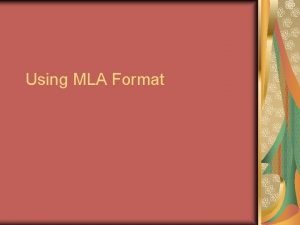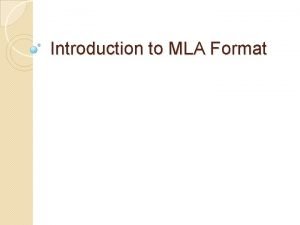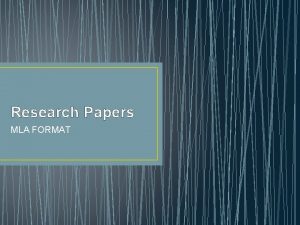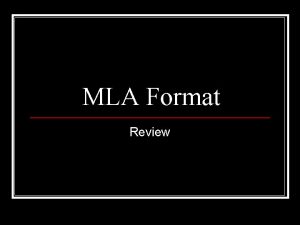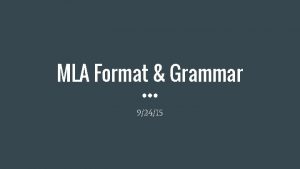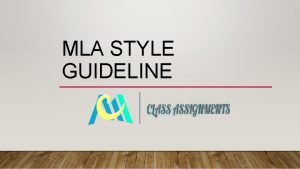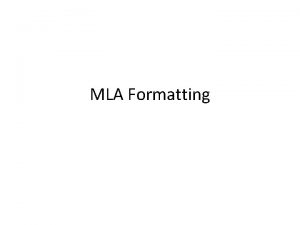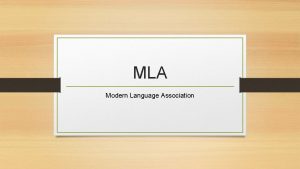MLA Format What is MLA Stands for Modern















- Slides: 15

MLA Format

What is MLA? Stands for Modern Language Association w Is used to format research papers and reports. w w Has a specific set of guidelines w Lots of Internet resources available

Formatting 1 st Page Double-space entire document w 1” margins – top, bottom, left, right w w Use Times New Roman, size 12 font – ALWAYS Heading is on left, has a specific order w Title is centered, not bolded, not underlined w In the header section, right side – page number, last name w w Paragraphs are indented w NO extra spaces between heading, title, and document

Example

In-Text Citations Parenthetical reference, used for citing w At end of quote or reference, in parentheses the author’s last name and page number – (Smith 23) is before the final punctuation of the sentence. w w If an electronic source is used with no author, use the article TITLE, not the web address – (“Impact of Global Warming”) – if there is no page number on the website, leave it out. w More than 1 author – use commas between last names – (Smith, Wesson, and Blue 45)

Quotations w All quotes are double-spaced. w Short quotes are four typed lines or less and are enclosed in quotation marks within the document. w Long quotes are indented 1” from the left margin and you leave off the quotation marks. The quote starts on its own line and the reference is after the punctuation.

Works Cited Page – Basic Rules Starts on own page at end of document – insert page break to move to next page at end of document. w Last page of the document w w Title of page is centered – Works Cited w References are double-spaced with hanging indent and in alphabetical order

New Rules No longer required to use the web address – is a teacher option w Must include the medium of the source, most are going to be either print or web but could also include video, CD, DVD, Film w w Use italics (instead of underlining) for titles of larger works (books, magazines) and quotation marks for titles of shorter works (poems, articles)

Basic Format - Book The author’s name or a book with a single author's name appears in last name, first name format. The basic form for a book citation is: w Last name, First name. Title of Book. Place of Publication: Publisher, Year of Publication. Medium of Publication. w A book with NO author would appear like this: w Encyclopedia of Indiana. New York: Somerset, 1993. Print. w

Use of URLs in MLA w For instructors or editors who still wish to require the use of URLs, MLA suggests that the URL appear in angle brackets after the date of access. Break URLs only after slashes: Aristotle. Poetics. Trans. S. H. Butcher. The Internet Classics Archive. Web Atomic and Massachusetts Institute of Technology, 13 Sept. 2007. Web. 4 Nov. 2008. ‹http: //classics. mit. edu/›.

Basic Format - Electronic w Here are some common features you should try and find before citing electronic sources in MLA style. Not every Web page will provide all of the following information. However, collect as much of the following information as possible both for your citations and for your research notes: • Author and/or editor names (if available) • Article name in quotation marks (if applicable) • Title of the Website, project, or book in italics. (Remember that some Print publications have Web publications with slightly different names. They may, for example, include the additional information or otherwise modified information, like domain names [e. g. . com or. net])

More: Any version numbers available, including revisions, posting dates, volumes, or issue numbers. w Publisher information, including the publisher name and publishing date. w w Take note of any page numbers (if available). w Medium of publication. w Date you accessed the material. w URL (if required, or for your own personal reference). w Note: Use n. p. to indicate that neither a publisher nor a sponsor name has been provided. Use n. d. when the Web page does not provide a publication date.

Format w Remember to use n. p. if no publisher name is available and n. d. if no publishing date is given: Editor, author, or compiler name (if available). Name of Site. Version number. Name of institution/ organization affiliated with the site (sponsor or publisher), date of resource creation (if available). Medium of publication. Date of access.

Examples for Electronic Sources: "How to Make Vegetarian Chili. " e. How. com. e. How, n. d. Web. 24 Feb. 2009. Klee, Paul. Twittering Machine. 1922. Museum of Modern Art, New York. The Artchive. Web. 22 May 2006. The Purdue OWL Family of Sites. The Writing Lab and OWL at Purdue and Purdue U, 2008. Web. 23 Apr. 2008. Note: not double-spaced here for visual purpose

Resources: http: //owl. english. purdue. edu/owl/resource/747/01/ w http: //www. mla. org w w http: //myweb. wssu. edu/wallr/mla_format. htm Citation Builder: http: //www. calvin. edu/library/knightcite/
 What does mla stand for
What does mla stand for Modern language association mla format
Modern language association mla format Mla uses this in text citation castro
Mla uses this in text citation castro Fspos vägledning för kontinuitetshantering
Fspos vägledning för kontinuitetshantering Novell typiska drag
Novell typiska drag Nationell inriktning för artificiell intelligens
Nationell inriktning för artificiell intelligens Returpilarna
Returpilarna Varför kallas perioden 1918-1939 för mellankrigstiden?
Varför kallas perioden 1918-1939 för mellankrigstiden? En lathund för arbete med kontinuitetshantering
En lathund för arbete med kontinuitetshantering Särskild löneskatt för pensionskostnader
Särskild löneskatt för pensionskostnader Vilotidsbok
Vilotidsbok Sura för anatom
Sura för anatom Vad är densitet
Vad är densitet Datorkunskap för nybörjare
Datorkunskap för nybörjare Boverket ka
Boverket ka Mall för debattartikel
Mall för debattartikel

